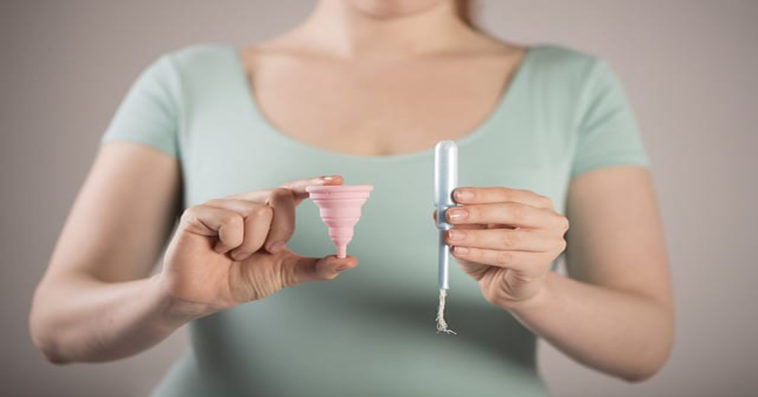For women, one period every month brings pain to their daily routine. But you can handle your menstrual days with less waste and more care for yourself.
There are acne breakouts, mood swings, muscle pains – as if we ran a mile – extra stressful days, and whatnot. Menstrual days challenge a woman’s patience in EVERYTHING! Yes. Everything. Dealing with menstrual pain is tedious and arduous. You can feel all pain joining forces, making you suffer for about 4 to 7 days – lucky enough for those who only experience menstruation within four days. Changing pads or tampons even brings inconvenience to its highest level. Despite using the best pad or tampon, it doesn’t slacken the amount of pain a woman has to endure for almost an entire week.
The pain accompanied by menstruation is not only limited to abdominal pains. Some women I know experiences nausea, vomiting, or even dysmenorrhea. This happens because of hormonal and chemical changes which occur during the cycle.
What is menstrual cycle?
Mayo Clinic defines the menstrual cycle as “the monthly series of changes a woman’s body goes through in preparation for the possibility of pregnancy.” A woman’s uterus grows and sheds a lining that could support the egg’s development in preparation for pregnancy.

Its common physical symptoms are the following:
- Pain in the lower abdomen
- Muscle pain (hips, thighs, back)
- Lightheadedness
- Dysmenorrhea
- Fatigue
- Vomiting
- Breast soreness
- Constipation
- Bloating
Its common mental symptoms are the following:
- Anxiety
- Irritability
- Panic attacks
- Sleep issues
All these are symptoms of menstruation and the physical pain it accompanies. However, as a woman, the pain itself is not the only complication one feels. The inconvenience of constantly changing pads and tampons is on the front lines. One more thing, due to the constant changing of pads and tampons, we are also contributing to Earth’s waste that either destroys the environment or could allow the environment to breathe due to its sustainable benefits.
Imagine all the sanitary items, packaging, and whatnot. It only gives off more stress during period days. In connection to that, how do hygienic napkins contribute to our Environment’s condition?
Environmental Impacts of Your Period
Toni Sparks reported in 2020, “Big brand sanitary napkins consist of up to 90% plastic—the equivalent of four plastic bags”. Moreover, given that these are made of polyethylene and other plastics, it is a non-biodegradable item. Recycle? Why didn’t I think of that? Hmmm.
Sadly, they aren’t recyclable either. I mean, it’s full of blood. Thus, it is under medical waste that can’t be recycled. Another study shows that a woman’s tampons and pads are approximately 11,000, while records show that it even reaches 16,000. Yikes! I can’t believe that natural changes in a woman’s body can contribute that much in terms of waste – referring to the tampons and pads used and discarded per month.

Given that plastics are the main components which make up these sanitary items, it takes years before it decomposes. Approximately 600 years for it to decompose – yet it depends on the temperature. Thinking about it adds up to the stress that period days give. Just imagine that a hundred and twenty-five (125) year menstrual pad invented way back is still sitting and not so pretty, up to this very day; or they could be floating around the Pacific Ocean for all we know.
Another thing, no one talks about it. Have you ever heard from a friend how tampons and pads contribute to Earth’s waste and out and about encouraging everyone to go more organic and sustainable? No? I think so too. Talks about menstruation and its hygienic items are not a common subject to dwell on at a tea party or sleepovers with friends. There is like a big wall which forbids women to talk about it freely, at least in front of male friends – but still, sometimes it is also as awkward when you talk about it in front of women or even children.
Is it because it’s a private experience? It’s not like asking a friend about the kind of deodorant they use or what shampoo is more convenient to use. Despite falling under hygienic items, talks about menstruation – pads & tampons – are like a taboo. At least, that what I noticed. Hence, its contribution to Earth’s waste and pollution is overlooked. Up to this very day, I haven’t heard from any on barnstorming regarding its environmental impacts.
Hygienic products may appear clean as it is, but their impact on women’s health is risky. Women’s Voices of the Earth published a study in 2014 which shows that there are chemicals found on sanitary napkins that are toxic and can put a woman’s health at risk. Notice that liquid-like gel at the center of your pad – often in the color of blue? Commonly known as “absorbent gel.”
Mrs. Kokila Alangaram said, in one of her talks in an organized session at Mango Education, “The fiber absorbent pads that make the period ‘safe’ is actually the cause for cervical cancer.” I already heard rumors regarding this matter, and indeed, some can be detrimental. “Cellulose gel is what assists in absorption and controls leakage but we confuse it with cotton.” she added. Apart from that, I also experience having rashes around the corners of my private area due to irritation. The synthetic material, which we often confuse with cotton, leads to rashes.
Hence, to avoid these detrimental risks to our health while practicing Zero-Waste even in our period days, I listed important notes and several products that we, women, can use when red days are at their peak. We have to take care of ourselves extra carefully.
Zero Waste Period Tools
When I say total Zero-Waste, I meant everything. From what we eat to our clothes, and of course, our hygienic items. I mean, we all get asked how we handle ourselves during our red days. Hence, the list below shows how you can take care of yourself without compromising your health and the environment.
Period Panties
Come on, like, it’s finally time to save ourselves from going through these rashes during our red days. It’s time to finally get our money’s worth without compromising our health and the environment. Plus, it is sustainable.
Period panties look like regular undies but are made for absorbing the blood of worth two tampons/pads. Also, should you wish to feel still chic, Thinx also offers thongs. A go-to period panty product.
How does it work?
- Leak-resistant barrier
- Super absorbent
- Moisture-wicking cotton
- Fights odors and bacteria
Menstrual Cup

Please don’t ever say no to this product. Just don’t! The only reason women are scared of using it is that it’s a ‘foreign’ object getting inserted inside the vagina. Uhm? Technically, you insert tampons in. What difference does it make? Health risks? You only have to purchase a legit and the correct menstrual cup for you. Get the right size, and you are good to go. It is reusable. Plus, remember the inconvenience of constantly going to the bathroom after 4 to 5 hours to change pads and make sure that there are no stains?
I know, right! Stressful and hassle enough. Fret no more because menstrual cups can save your time. They are made with medical-grade silicone and leak-free. Furthermore, it can also be used at night, approximately 12hours. Although it can be expensive for a bit, you will get your money’s worth. Quality over quantity, they say. And boy, it is!
How to use a menstrual cup?
- Please read the instructions given. That’s the number 1 step.
- Sterilize the cup before using. Make sure that it is clean and disinfected thru boiling water and soaking it for about 2 minutes.
- Make sure that your hands are also clean before inserting it in. Thus, fold the cup in half.
- Insert the folded cup inside the vagina and allow it to pop open once it is past the pubic bone fully.
- Fret no more in terms of removing it because there is a tip which you can pull. However, you do not just pull it automatically or its contents will spill (we don’t want that, especially when we are in public comfort rooms). Carefully squeeze the bottom part of the cup and slowly remove it from the vagina.
Do not forget to rinse it with cold water for sanitary purposes and eventually wash it with hot water to sterilize it once again. Store it in ventilated areas.
Organic tampons and pads
Organic tampons and pads are highly encouraged to use. Why? Because they are biodegradable. Meaning, your used organic tampons, and pads will not end up piling on landfills or, worse, in the oceans. As long as you ensure to break it up like cutting it, perhaps, then you’re good to go. It will naturally decompose, and you were able to help the environment.
Everything organic is a point that can be added to our environment’s survival. Thus, always think about the benefits of your purchases and make sure they are organic. There is nothing wrong if you still prefer wearing tampons and pads over menstrual cups and period panties. Just make sure that they are legit eco-friendly and healthy for your body.
Reusable Cloth Pads
They are basically like regular pads, but they are made of cloth that is good for the skin. There is a snap button that will ensure that it will stay on your undies. They are disposable and reusable at the same time, so you can ideally use them. Going for reusable items can save you some money, and you can never go wrong.
Bamboo Pads
Have you ever heard of them? They work just like regular pads, but it’s healthier for you to use. What’s so great about it? Well, it is made of Oeko-Tex bamboo and Non-GMO corn fiber for a soft super-absorbent yet ultra-thin towel that stays put with wings.
Self-care habits during your period
We all desire to have a painless period, but sadly, it’s not that possible. All we can do is alleviate the pain and make it bearable to get through the day. The following are few tips on how to take care of yourself during period days without stressing too much over the pain.
Exercise
Please don’t come at me for putting this in the number one spot. But it’s true. Exercising helps alleviate period cramps. And apart from its other significant benefits, it’s an option that women must consider when red days are coming. Personal experience – I experience fewer period cramps due to my constant exercise. Although certain days are still painful, it’s not as painful as how I experience it before.
Magnesium
Kathryn Kellogg says, “magnesium has been proven to relax muscles reduce cramps, and help with migraines.” And because period days can be exhausting, it can also help you regain your energy and prevent you from getting extra exhausted. Try cacao because it has 40g of magnesium.
Healthy Fats
Period pains are caused by prostaglandins which increase your body’s sensitivity to pain. To avoid that, consume healthy fats. Consume processed foods high in saturated fat – red meat.
Hot packs or hot shower
Applying hot packs or soaking under a hot tub can help alleviate period cramps as it relaxes the muscles in your body. Just make sure that it’s not hot enough to burn your skin.
Orgasm
Orgasm can relax the muscles in your body. Hence, you can try it some time if you can.




